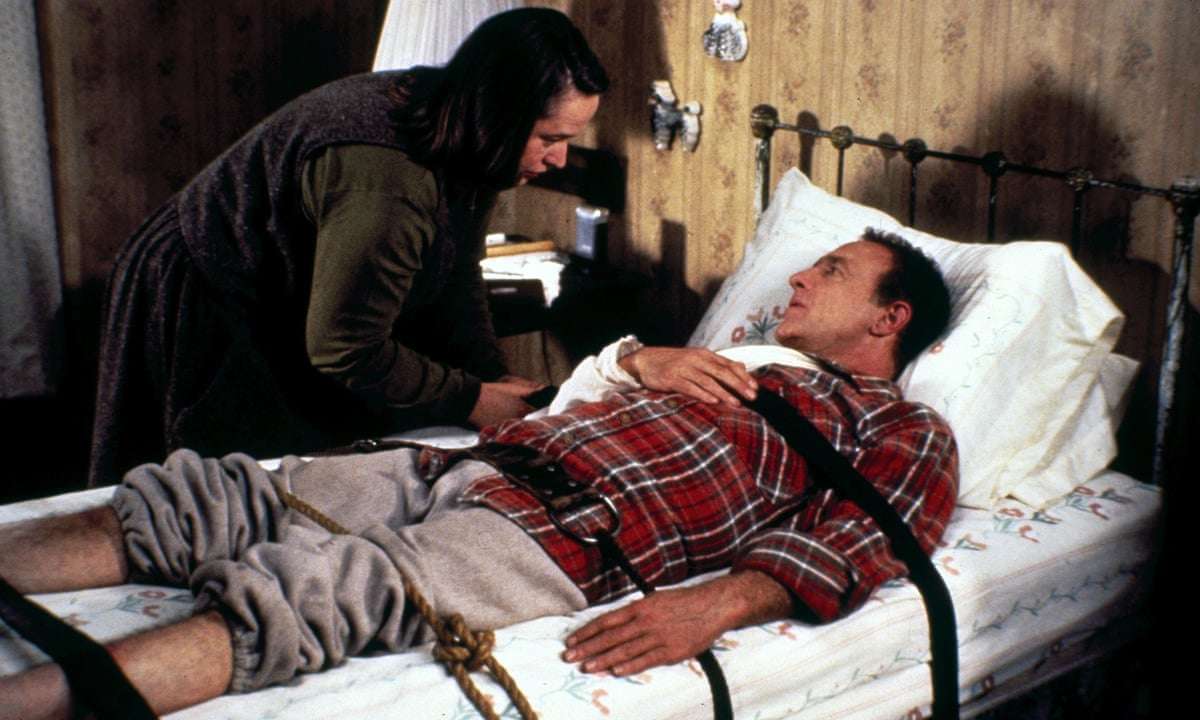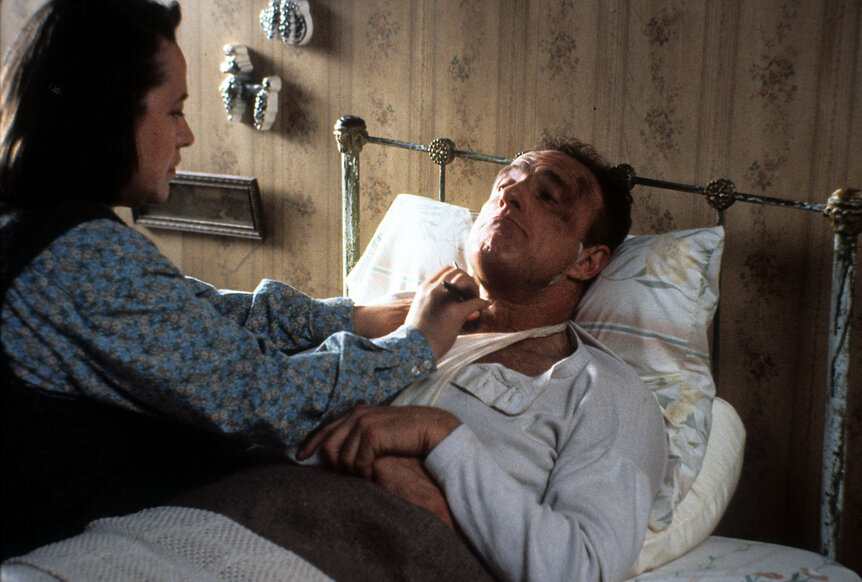Create a free profile to get unlimited access to exclusive videos, sweepstakes, and more!
Why Misery is now an underrated Stephen King masterpiece

In 1990, Misery was a big deal.
During the holiday season, director Rob Reiner’s adaptation of Stephen King’s disturbing 1987 novel opened at No. 2. (behind the unstoppable Home Alone) and remained in the top 10 for six weeks. Word-of-mouth helped the film become a sleeper hit — one of 1990’s highest-grossing movies — and a major awards contender that landed Kathy Bates the Academy Award for Best Actress.
Yet, 30 years later, outside of Film Twitter, Misery seems to have slipped in between the couch cushions of pop culture. Its anniversary this week is a perfect occasion to revisit this underrated masterpiece — and see why it is one of the best films ever based on a Stephen King book.
The only thing more terrifying than Misery is how close the film came to not being made at all. For years, production company Castle Rock and Reiner — the latter riding high off the success of his first King adaptation, Stand By Me — weathered several levels of Development Hell in their struggle to convince Hollywood to take a chance on what is essentially a chamber piece: an old-fashioned “two-hander” put through the lens of the Master of Horror. (It’s not surprising that the film was recently adapted into a short-lived Broadway play).
In adapting the story of novelist Paul Sheldon (James Caan) struggling to survive under the psychotic care of his number one fan, Annie Wilkes (Bates, in her Oscar-winning role), screenwriter William Goldman (Butch Cassidy and the Sundance Kid) created the screenwriting equivalent of catnip for actors. The movie would live or die on the performances and chemistry of whoever was cast in the lead roles. And with the right people in place, it would likely attract awards consideration.
But Hollywood’s A-List, circa 1990, wouldn’t bite (crazy, right?). Robert De Niro, Al Pacino, Harrison Ford, Robert Redford, and Michael Douglas are among the marquee actors who passed on the role of Paul. William Hurt turned it down. Twice. Reiner almost had Warren Beatty locked in, but ultimately passed because (sigh) Beatty wanted to turn Paul — who is confined to a bed for most of the film due to his injuries — into a less passive character. (Beatty also at the time claimed that he couldn’t commit to the role in part due to extended post-production on his over-budget Dick Tracy.)
Had the filmmakers executed Beatty’s notes, Misery would have certainly faltered creatively and financially. (It also flies against the core conceit of the source material and the appeal to turn it into a movie at all). Because a significant part of Misery’s success is how Paul’s plight becomes our worst fear. We instantly relate to the nightmare of not only being hurt and trapped in a deranged stranger’s house, but also being incapable of doing anything about it. Paul, and by proxy the audience, is on his own. The only one who can save Paul is Paul. That narrative choice means that every panicked breath Paul takes or small victory he earns, it feels like one of our own. Misery is so engaging because we are at ground level with Paul as he figures out ways to get out of this mess — with the walls closing in the more Annie spirals into madness.
And Caan is fully committed to selling this frightening, and ultimately empowering experience. Paul being the more “reactive” character, until the third act when he gets free and goes on the offensive, was a feature and not a bug to The Godfather star. In 1990, Caan told The Los Angeles Times that playing a “totally reactionary character” is more challenging for an actor. It was that challenge that made Paul and Misery all the more appealing.
As great as Caan is in the role, as a hero, Paul is only as good as his villain. And Misery gives us an all-timer of an antagonist. (If it wasn’t for Goldman recommending Bates to Reiner, fans would have missed out on seeing one of the genre’s greatest performances.) On paper, it may seem like Annie is a one or two-note character. But Annie is much more complicated than that. A former nurse-turned-batty recluse, Annie is easily dismissed by her small snowy town. Which explains why Annie seemingly thrives on being underestimated. She presents one face to the locals, another to Paul — the object of her violent obsession — and then another to herself when her child-like rage and homicidal tendencies prove too powerful for what’s left of her threadbare sanity to keep in check.
Sometimes, Annie even wears some or all of these faces at once. Making her all the more dangerous to Paul, and horrifying to us, because of her unpredictability. One minute, she’s surprisingly charming and kind, like when she first rescues Paul from a car accident in the middle of a snowstorm. The next minute, she’s dead-eyed and taking a sledgehammer to Paul’s legs. Bates invests each of these moments with the exact amount of whatever they need to unsettle audiences. That way, audiences are constantly white-knuckling their armrests while the movie mainlines an unrelenting sense of tension and dread as Annie’s obsession threatens to destroy both her and Paul. Her erratic (at best) behavior draws us to Paul even more, rooting for him to get out of this box of crazy — even if it means taking Annie out in the process.
It’s that desire for Paul to not only escape, but overcome and defeat his oppressor, that raises the stakes (and our blood pressure) in the final 20 minutes of the film. Here, Paul lulls Annie into a false sense of security and control after “rewriting” a new novel that gives Paul’s most popular character (and Annie’s favorite), Misery, an ending more to Annie’s liking. When Paul is not working on the typewriter, or under Annie’s watchful eye, he takes breaks to build back his strength. Moreover, Paul convinces both us and Annie that he is writing a legit new Misery novel, but — in reality — it is all a ruse. One that Paul commits so fully to that we don’t realize we have been duped by him until Annie does. One of the longest cons ever delivers one of the best payoffs, as Paul burns the story he wrote for Annie. Right in front of her. Writing the novel was all a distraction, a smokescreen Paul uses to stage his violent exodus from his tormentor’s prison. Paul’s escape plan causes him more pain and suffering at Annie’s hands, but it ultimately earns him his freedom — and costs Annie her life.
But in true Stephen King fashion, there’s one final psychological twist. Eighteen months after surviving Annie, a still-recovering Paul dines with his literary agent (Lauren Becall) in New York. As they discuss his trauma, and the good buzz surrounding his first post-Misery novel, Paul reveals he wrote his new book as a way to process and cope with the emotional and mental damage from his encounter with Annie. When Paul’s agent asks him if he would ever consider writing a non-fiction account of his ordeal, we see why he turns it down. Because Paul turns and sees Annie approaching him. Then realizes he is hallucinating; it wasn’t Annie, it was his server. When the waitress approaches the meekly-looking author, she echoes Annie’s foreboding line: “I’m your number one fan.”
While Paul is physically free, his psyche is still strapped to that bed in Annie’s house. Struggling to heal as his PTSD threatens to reopen old wounds. Another brilliant masterstroke in a movie full of them, one that further cements Misery as a modern classic and horror masterpiece. One that leaves its audience as haunted as the writer they’ve spent the last two hours watching.



























